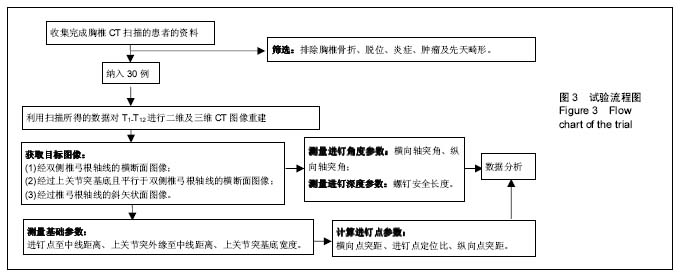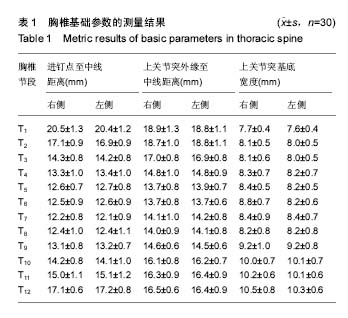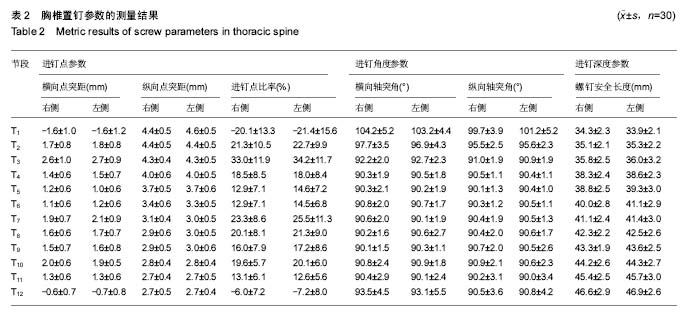中国组织工程研究 ›› 2017, Vol. 21 ›› Issue (35): 5622-5629.doi: 10.3969/j.issn.2095-4344.2017.35.008
• 脊柱植入物 spinal implant • 上一篇 下一篇
以上关节突确定正常成人胸椎椎弓根置钉参数的影像学测量
卢政好1,李吉鹏2,周菁华3,王卫国4
- 南华大学附属南华医院,1脊柱外科,3放射科,湖南省衡阳市 421002;2金昌市人民医院骨科,甘肃省金昌市 737100;4中南大学湘雅三医院骨科,湖南省长沙市 410013
Determination of thoracic pedicle screw parameters by superior facet in normal adults: an imaging study
Lu Zheng-hao1, Li Ji-peng2, Zhou Jing-hua3, Wang Wei-guo4
- 1Department of Spinal Surgery, 3Department of Radiology, Nanhua Hospital Affiliated to South China University, Hengyang 421002, Hunan Province, China; 2Department of Orthopedics, Jinchang People’s Hospital, Jinchang 737100, Gansu Province, China; 4Department of Orthopedics, the Third Xiangya Hospital, Central South University, Changsha 410013, Hunan Province, China
摘要:
文章快速阅读:
.jpg)
文题释义:
椎弓根置钉参数:即椎弓根置钉内固定技术的三要素,包括进钉点、进钉角度和进钉深度。进钉点是指施行该技术时选择的螺钉进入点,理论上应与椎弓根轴线在脊柱后柱表面的投影点重合。进钉角度是指螺钉的前进方向,理论上螺钉轴心线应与椎弓根轴线重合。进钉深度是指选择的螺钉的长度,安全的螺钉长度应使螺纹全长位于骨质内。选择正确的进钉点是成功施行该技术的前提,因为它决定了进钉角度和进钉深度。在颈胸椎,由于其椎弓根横径比较细小,进钉点和进钉角度的精确确定是成功施行该技术的关键,因为它决定了螺钉能否沿椎弓根轴线置入。
上关节突:是椎弓根与椎板结合处伸向上方的骨性突起,与上位椎骨下关节突构成关节突关节。胸椎上关节突关节面较为平直,略向后上外方,基本呈冠状位。以上关节突为单一标志或联合标志确定椎弓根进钉点,已见较多文献报道。明确椎弓根进钉角度和上关节突关节面之间的角度关系,可为胸椎椎弓根置钉内固定技术提供一种安全、简便的确定进钉角度的方法。
摘要
背景:现有的胸椎椎弓根置钉内固定技术均以上关节突或联合横突为参考标志确定进钉点,以假想的横断面和矢状面为参考标志确定进钉角度,诸位学者描述不一。由于患者术中体位的影响和术者主观判断的偏差,易出现螺钉误置,产生严重并发症,限制了该技术的临床应用和推广。目前,临床上选择一个单一的不受患者体位影响且容易判断的骨性标志作为胸椎椎弓根置钉进钉点和进钉角度的参考,显得尤为重要。
目的:通过三维重建CT图像的测量探讨正常成人胸椎以上关节突作为单一解剖标志确定椎弓根置钉参数的可行性及其具体的对应关系。
方法:选取30例正常成人胸椎CT图像进行三维重建,在重建后的T1-T12特定CT图像上直接测量以下参数:①基础参数:包括进钉点至中线距离、上关节突外缘至中线距离和上关节突基底宽度。通过基础参数间接计算进钉点参数,包括横向点突距、进钉点比率和纵向点突距,即进钉点至上关节突外缘的水平距离及其与上关节突基底宽度的比率和进钉点至上关节突基底的垂直距离;②进钉角度参数:横向轴突角和纵向轴突角,即横断面和矢状面上椎弓根轴线与上关节突关节面的夹角;③进钉深度参数:螺钉安全长度,即椎弓根轴线上进钉点至椎体前缘骨皮质的距离。统计每组参数的平均值和标准差,并比较各节段统计数据的差异。
结果与结论:①利用三维重建CT技术,可以成功获取T1-T12经双侧椎弓根轴线横断面、经上关节突基底且平行于双侧椎弓根轴线的横断面和经单侧椎弓根轴线斜矢状面的图像;②基础参数:T1-T12左右两侧进钉点至中线距离分别为(14.6±2.6) mm和(14.5±2.5) mm,上关节突外缘至中线距离分别为(15.7±1.9) mm和(15.7±2.0) mm,上关节突基底宽度分别为(8.8±1.3) mm和(8.8±1.1) mm。每一参数左右两侧测量值差异无显著性意义(P=0.343,0.214,0.467);③置钉参数:T1-T12左右两侧横向点突距分别为(1.2±1.3) mm和(1.3±1.4) mm,进钉点比率分别为(14.3±17.0) %和(13.6±16.1) %,纵向点突距分别为(3.4±0.8) mm和(3.3±0.9) mm,横向轴突角分别为(92.4±4.7)°和(92.6±5.0)°,纵向轴突角分别为(91.8±4.1)°和(91.7±3.6)°,螺钉安全长度分别为(40.7±4.8) mm和(40.4±4.6) mm。以上每一参数左右两侧测量值差异无显著性意义(P=0.073,0.084,0.310,0.265,0.241,0.175);④以上结果提示,正常成人胸椎以上关节突作为单一解剖标志确定椎弓根置钉参数简单可行,前者与后两者存在特定的对应关系,可作为一种新的临床上选择置钉参数的方法。
中图分类号:



.jpg)
.jpg)